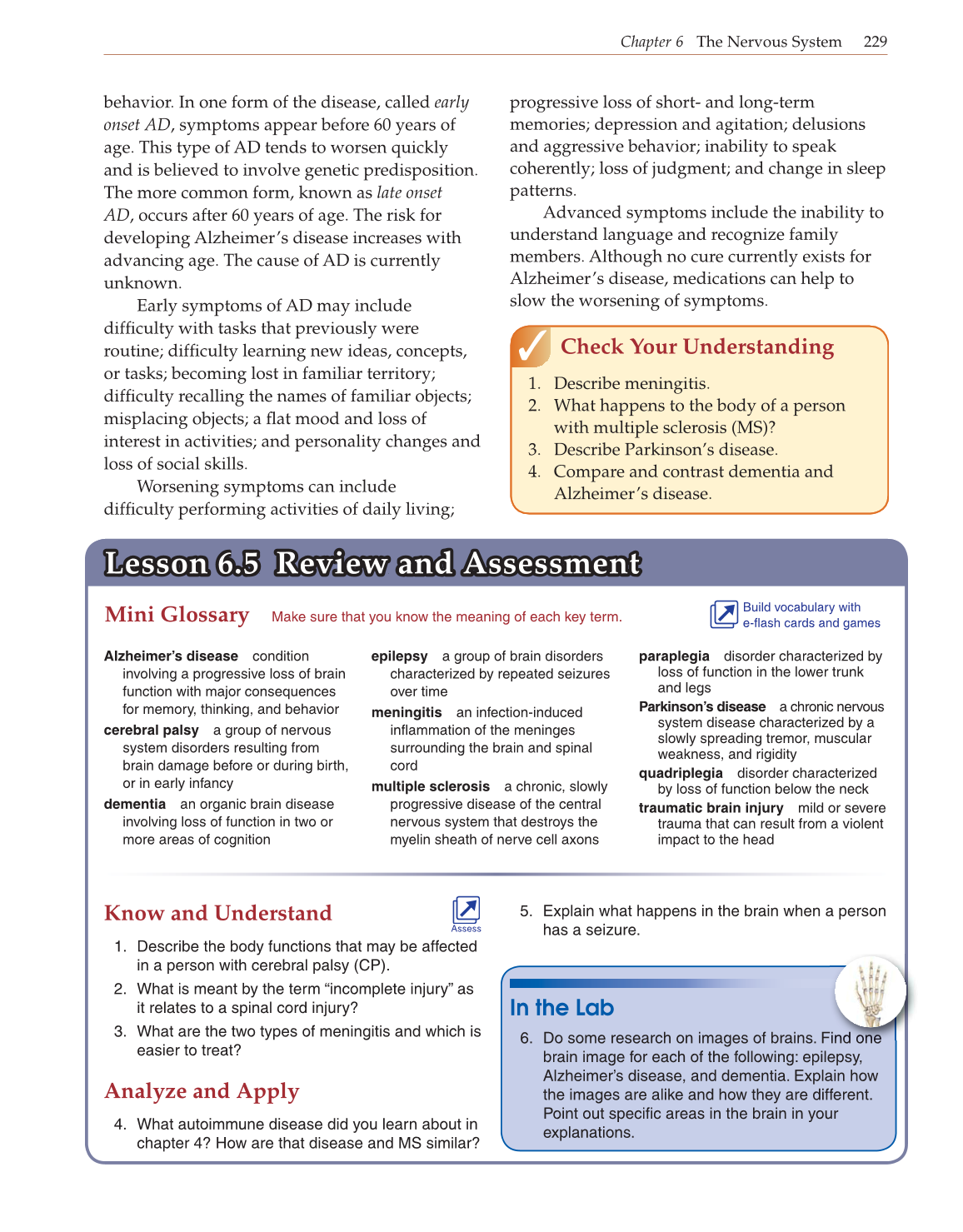Chapter 6 The Nervous System 229
behavior. In one form of the disease, called early
onset AD, symptoms appear before 60 years of
age. This type of AD tends to worsen quickly
and is believed to involve genetic predisposition.
The more common form, known as late onset
AD, occurs after 60 years of age. The risk for
developing Alzheimer’s disease increases with
advancing age. The cause of AD is currently
unknown.
Early symptoms of AD may include
diffi culty with tasks that previously were
routine; diffi culty learning new ideas, concepts,
or tasks; becoming lost in familiar territory;
diffi culty recalling the names of familiar objects;
misplacing objects; a fl at mood and loss of
interest in activities; and personality changes and
loss of social skills.
Worsening symptoms can include
diffi culty performing activities of daily living;
progressive loss of short- and long-term
memories; depression and agitation; delusions
and aggressive behavior; inability to speak
coherently; loss of judgment; and change in sleep
patterns.
Advanced symptoms include the inability to
understand language and recognize family
members. Although no cure currently exists for
Alzheimer’s disease, medications can help to
slow the worsening of symptoms.
1. Describe meningitis.
2. What happens to the body of a person
with multiple sclerosis (MS)?
3. Describe Parkinson’s disease.
4. Compare and contrast dementia and
Alzheimer’s disease.
Check Your Understanding
Lesson 6.5 Review and Assessment Lesson 6.5 Review and Assessment
Mini Glossary
Make sure that you know the meaning of each key term.
Alzheimer’s disease condition
involving a progressive loss of brain
function with major consequences
for memory, thinking, and behavior
cerebral palsy a group of nervous
system disorders resulting from
brain damage before or during birth,
or in early infancy
dementia an organic brain disease
involving loss of function in two or
more areas of cognition
epilepsy a group of brain disorders
characterized by repeated seizures
over time
meningitis an infection-induced
infl ammation of the meninges
surrounding the brain and spinal
cord
multiple sclerosis a chronic, slowly
progressive disease of the central
nervous system that destroys the
myelin sheath of nerve cell axons
paraplegia disorder characterized by
loss of function in the lower trunk
and legs
Parkinson’s disease a chronic nervous
system disease characterized by a
slowly spreading tremor, muscular
weakness, and rigidity
quadriplegia disorder characterized
by loss of function below the neck
traumatic brain injury mild or severe
trauma that can result from a violent
impact to the head
Build vocabulary with
e-fl ash cards and games
Know and Understand
1. Describe the body functions that may be affected
in a person with cerebral palsy (CP).
2. What is meant by the term “incomplete injury” as
it relates to a spinal cord injury?
3. What are the two types of meningitis and which is
easier to treat?
Analyze and Apply
4. What autoimmune disease did you learn about in
chapter 4? How are that disease and MS similar?
Assess
5. Explain what happens in the brain when a person
has a seizure.
6. Do some research on images of brains. Find
brain image for each of the following: epilepsy,
Alzheimer’s disease, and dementia. Explain how
the images are alike and how they are different.
Point out specifi c areas in the brain in your
explanations.
In the Lab
Find oone ne
